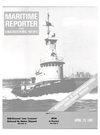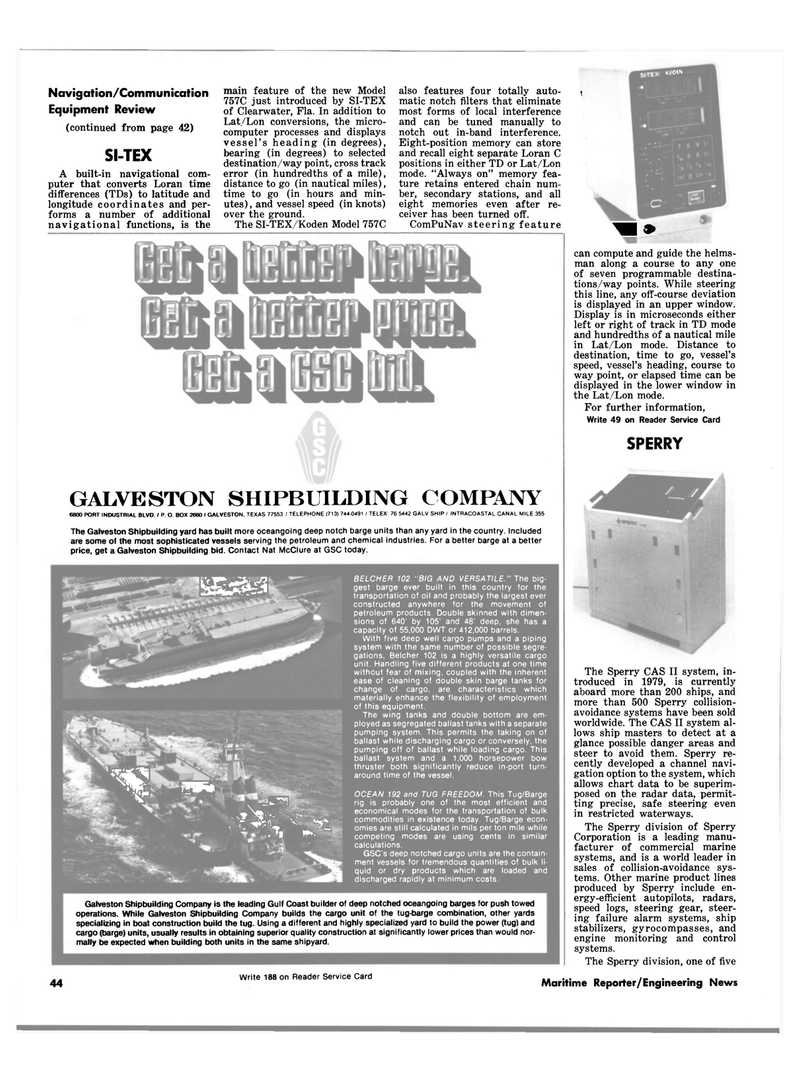
Page 42: of Maritime Reporter Magazine (April 15, 1981)
Read this page in Pdf, Flash or Html5 edition of April 15, 1981 Maritime Reporter Magazine
KSOtN
Navigation/Communication
Equipment Review (continued from page 42)
SI-TEX
A built-in navigational com- puter that converts Loran time differences (TDs) to latitude and longitude coordinates and per- forms a number of additional navigational functions, is the main feature of the new Model 757C just introduced by SI-TEX of Clearwater, Fla. In addition to
Lat/Lon conversions, the micro- computer processes and displays vessel's heading (in degrees), bearing (in degrees) to selected destination/way point, cross track error (in hundredths of a mile), distance to go (in nautical miles), time to go (in hours and min- utes), and vessel speed (in knots) over the ground.
The SI-TEX/Koden Model 757C also features four totally auto- matic notch filters that eliminate most forms of local interference and can be tuned manually to notch out in-band interference.
Eight-position memory can store and recall eight separate Loran C positions in either TD or Lat/Lon mode. "Always on" memory fea- ture retains entered chain num- ber, secondary stations, and all eight memories even after re- ceiver has been turned off.
ComPuNav steering feature t ^ » can compute and guide the helms- man along a course to any one of seven programmable destina- tions/way points. While steering this line, any off-course deviation is displayed in an upper window.
Display is in microseconds either left or right of track in TD mode and hundredths of a nautical mile in Lat/Lon mode. Distance to destination, time to go, vessel's speed, vessel's heading, course to way point, or elapsed time can be displayed in the lower window in the Lat/Lon mode.
For further information,
Write 49 on Reader Service Card
SPERRY
The Sperry CAS II system, in- troduced in 1979, is currently aboard more than 200 ships, and more than 500 Sperry collision- avoidance systems have been sold worldwide. The CAS II system al- lows ship masters to detect at a glance possible danger areas and steer to avoid them. Sperry re- cently developed a channel navi- gation option to the system, which allows chart data to be superim- posed on the radar data, permit- ting precise, safe steering even in restricted waterways.
The Sperry division of Sperry
Corporation is a leading manu- facturer of commercial marine systems, and is a world leader in sales of collision-avoidance sys- tems. Other marine product lines produced by Sperry include en- ergy-efficient autopilots, radars, speed logs, steering gear, steer- ing failure alarm systems, ship stabilizers, gyrocompasses, and engine monitoring and control systems.
The Sperry division, one of five
GALVESTON SHIPBUILDING COMR4NY 6800 PORT INDUSTRIAL BLVD. I P. O. BOX 2660 I GALVESTON. TEXAS 77553 I TELEPHONE (713) 744-0491 I TELEX: 76 5442 GALV SHIP I INTRACOASTAL CANAL MILE 355
The Galveston Shipbuilding yard has built more oceangoing deep notch barge units than any yard in the country. Included are some of the most sophisticated vessels serving the petroleum and chemical industries. For a better barge at a better price, get a Galveston Shipbuilding bid Contact Nat McClure at GSC today. mm i
M \ HPifci : . v ; / f '•• v- \ m. -
BELCHER 102 "BIG AND VERSATILE." The big- gest barge ever built in this country for the transportation of oil and probably the largest ever constructed anywhere for the movement of petroleum products. Double skinned with dimen- sions of 640' by 105' and 48' deep, she has a capacity of 55,000 DWT or 412,000 barrels.
With five deep well cargo pumps and a piping system with the same number of possible segre- gations, Belcher 102 is a highly versatile cargo unit. Handling five different products at one time without fear of mixing, coupled with the inherent ease of cleaning of double skin barge tanks for change of cargo, are characteristics which materially enhance the flexibility of employment of this equipment.
The wing tanks and double bottom are em- ployed as segregated ballast tanks with a separate pumping system. This permits the taking on of ballast while discharging cargo or conversely, the pumping off of ballast while loading cargo. This ballast system and a 1,000 horsepower bow thruster both significantly reduce in-port turn- around time of the vessel.
OCEAN 192 and TUG FREEDOM. This Tug/Barge rig is probably one of the most efficient and economical modes for the transportation of bulk commodities in existence today. Tug/Barge econ- omies are still calculated in mils per ton mile while competing modes are using cents in similar calculations.
GSC's deep notched cargo units are the contain- ment vessels for tremendous quantities of bulk li- quid or dry products which are loaded and discharged rapidly at minimum costs.
Galveston Shipbuilding Company is the leading Gulf Coast builder of deep notched oceangoing barges for push towed operations. While Galveston Shipbuilding Company builds the cargo unit of the tug-barge combination, other yards specializing in boat construction build the tug. Using a different and highly specialized yard to build the power (tug) and cargo (barge) units, usually results in obtaining superior quality construction at significantly lower prices than would nor- mally be expected when building both units in the same shipyard. 44 Write 188 on Reader Service Card Maritime Reporter/Engineering News

 41
41

 43
43
